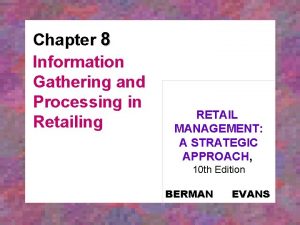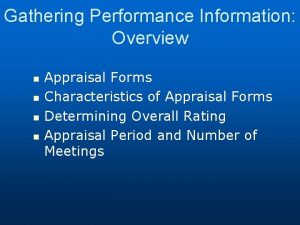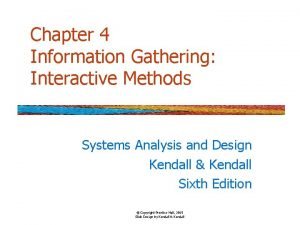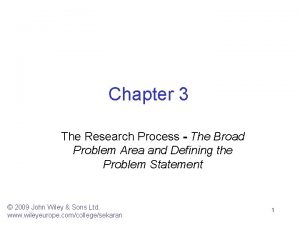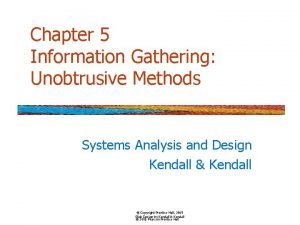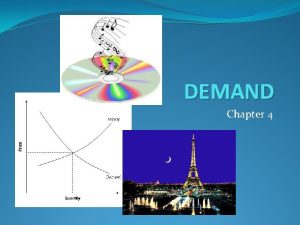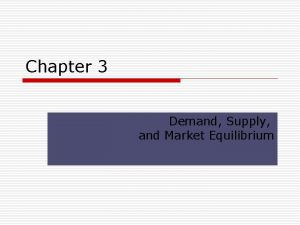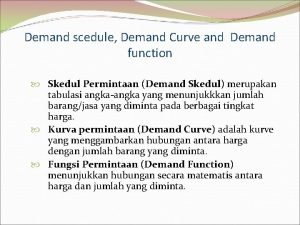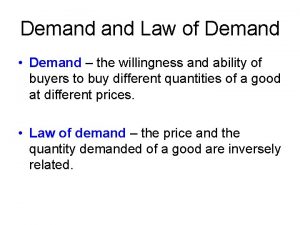Chapter 3 Gathering Information and Measuring Market Demand































- Slides: 31

Chapter 3 Gathering Information and Measuring Market Demand by Ung Veasna, DBA candidate

Kotler on Marketing is becoming a battle based more on information than on sales power.

Why Research? • The primary job of marketing managers is the design and execution of marketing programme • Before programmes can be designed, the market situation must be understood • In order to understand the market, the manager must have information • Before the marketing manager can have information, there must be data

Managers face three important problems in making more effective marketing decisions: !Obtaining the information they need for the flood of data that is available. !Interpreting the information !Determining what action should be taken

The Importance of Information • Companies need information about their: – Marketing environment – Competition – Customer needs • Managers don’t need more information, they need better information.

Marketing Environment Why Information Is Needed Strategic Planning Competition Customer Needs The Importance of Information

Research and Intelligence provide information necessary to clarify the “unknown. ”

The Benefit of Research • Discovering useful information about your customers, competition and environment • Reduces risk and uncertainty when making decisions • The “eyes” and “ears” of the corporation • Helps you get close to your customers

What is a Marketing Information System (MIS)? • A MIS consists of people, equipment, and procedures to gather, sort, analyze, evaluate and distribute needed, timely, and accurate information to marketing decision makers. • The MIS helps managers to: n Assess Information Needs, n Develop Needed Information, n Distribute Information.

The MIS and DATA INTERNAL EXTERNAL Data obtained from sources within the firm Data obtained from sources outside of the firm DATA PRIMARY Data collected for the first time SECONDARY Pre-existing data

Marketing Information System Components • • Internal Records Marketing Intelligence Marketing Decision Support Systems Marketing Research

Internal Record Systems • The Order-to-Payment Cycle • Sales Information Systems • Databases, Data Warehouses And Data. Mining • Customer records • Financial statements • Inventory records • Research reports • Credit data

The Marketing Intelligence System • A Marketing Intelligence System is a set of procedures and sources used by managers to obtain everyday information about developments in the marketing environment. • Intelligence: ongoing information

Marketing Decision Support System (MDSS) • A computer program - an interface - between the manager and the MIS • Makes it easy to obtain needed information • Makes it easy to analyse the information • May involve marketing models - to show the relationships among different marketing variables

Table 3 -1: Quantitative Tools Used in Marketing Decision Support Systems Statistical Tools 1. Multiple regression: A statistical technique for estimating a “best fitting” equation showing how the value of a dependent variable varies with changing values in a number of independent variables. Example: A company can estimate how unit sales are influenced by changes in the level of company advertising expenditures, sales force size, and price. 2. Discriminant analysis: A statistical technique for classifying an object or persons into two or more categories. Example: A large retail chain store can determine the variables that discriminate between successful and unsuccessful store locations. 3. Factor analysis: A statistical technique used to determine the few underlying dimensions of a larger set of intercorrelated variables. Example: A broadcast network can reduce a large set of TV programs down to a small set of basic program types. See text for complete table

Marketing Research is : a collection, processing and analysis of information on topics relevant to marketing. It begins with problem definition and ends with a reports and action recommendations (Lehmann, Gupta and Steckel 1998)

A Model of Marketing Research Problem Definition Research Design Secondary Data Primary Data Qualitative Quantitative Data Analysis Create Conclusions & Present

Figure 3 -2: The Marketing Research Process

• The Marketing Research Process – Step 1: Define the Problem, the Decision Alternatives, and the Research Objectives – Step 2: Develop the Research Plan • Data Sources • Research Approaches – – – Observational research Focus group research Survey research Behavioral data Experimental research

Gathering Information That Already Exists Somewhere. + Obtained More Quickly, Lower Cost. - Might Not be Usable Data. Both Must Be: Relevant Accurate Current Impartial Information Collected for the Specific Purpose at Hand.

Planning Primary Data Collection Research Approaches Observational Research Gathering data by observing people, actions and situations (Exploratory) Survey Research Asking individuals about attitudes, preferences or buying behaviors (Descriptive) Experimental Research Using groups of people to determine cause -and-effect relationships (Causal)

Sampling Plan – Sampling unit – Sample size – Sampling procedure

Sampling Plans Probability or Non-probability sampling? How should the sample be chosen? Sample representative segment of the population Who is to be surveyed? (What Sampling Unit? ) How many should be surveyed?

Research Instruments Questionnaire • What questions to ask? • Form of each question? • Closed-end • Open-end • Wording? • Ordering? Mechanical Devices • People Meters • Supermarket Scanners • Eye Cameras

Table 5 -2: Types of Questions A. Closed-end Questions Name Description Example Dichotomous A question with two possible answers. In arranging this trip, did you personally phone American? Yes No Multiple Choice A question with three or more answers. With whom are you traveling on this flight? Likert scale A statement with which the respondent shows the amount of agreement/ disagreement. No one Children only Spouse Business associates/friends/relatives Spouse and children An organized tour group Small airlines generally give better service than large ones. Strongly Disagree Neither agree Agree Strongly disagree nor disagree 1_____ 2 _____ 3_____ 4_____ 5_____

Step 3. Implementing the Research Plan Collec ting the Data Proces sing the Data Analy zing the Data Research Plan

Step 4. Interpreting & Reporting Findings Researcher Should Present Important Findings that are Useful in the Major Decisions Faced by Management. Step 1. Interpret the Findings Step 2. Draw Conclusions Step 3. Report to Management

Market Demand Definition • Market demand for a product is the total volume that would be – Bought by a defined customer group – In a defined geographical area – In a defined time period – In a defined marketing environment – Under a defined marketing program

Forecasting and Demand Measurement • The Measures of Market Demand Figure 33: Ninety Types of Demand Measure ment (6 X 5 X 3)

Sales Forecasting Methods Executive Opinion Customer Survey Sales Force Composite Analysis of market factors Trend Projection

Estimating Current Demand • Total Market Potential – 100 mil buyers X 3 books X $10/book • Area Market Potential – Above estimate by city, state, nation • Industry Sales – Market Build-up Method • Market Share – % of industry sales you expect to do.
 Demand measurement in marketing
Demand measurement in marketing Demand measurement in marketing
Demand measurement in marketing Time converstor
Time converstor Distinguish between individual demand and market demand
Distinguish between individual demand and market demand Market demand curve
Market demand curve Define market segmentation targeting and positioning
Define market segmentation targeting and positioning Information gathering and processing in retailing
Information gathering and processing in retailing Gathering information and scanning the environment
Gathering information and scanning the environment Information gathering in system analysis and design
Information gathering in system analysis and design Gathering information and scanning the environment
Gathering information and scanning the environment Gathering information and scanning the environment
Gathering information and scanning the environment Gathering information and scanning the environment
Gathering information and scanning the environment Current market demand
Current market demand Module 5 supply and demand introduction and demand
Module 5 supply and demand introduction and demand Market leader market challenger market follower
Market leader market challenger market follower Types of deflation
Types of deflation Gathering performance information
Gathering performance information Information gathering: interactive methods
Information gathering: interactive methods Identify a broad problem area examples
Identify a broad problem area examples Informasi pemasaran
Informasi pemasaran Unobtrusive methods of information gathering
Unobtrusive methods of information gathering The action or activity of gathering information
The action or activity of gathering information Gathering background information
Gathering background information Gathering background
Gathering background Maltego information gathering
Maltego information gathering Measures to correct deficient demand
Measures to correct deficient demand Example of independent demand
Example of independent demand Iskedyul ng demand
Iskedyul ng demand Demand forecasting in managerial economics
Demand forecasting in managerial economics Reorder point
Reorder point Gathering blue theme
Gathering blue theme Stochastic inventory model example
Stochastic inventory model example






